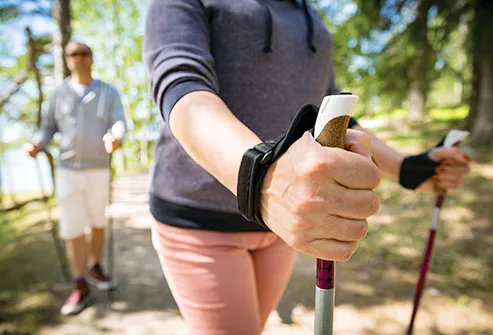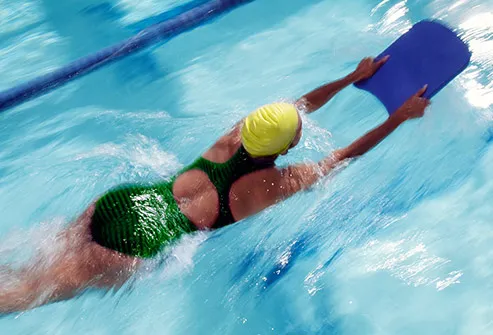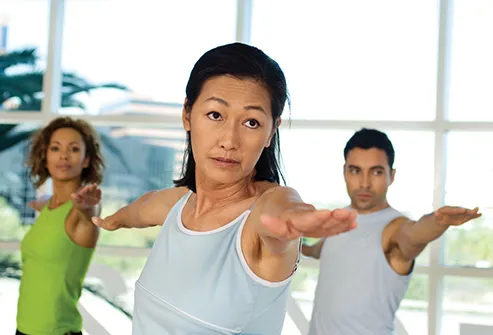10 Best Workouts for People Over 50

Let's face it: A 50- or 60-year-old body isn't the same as a 20-year-old one. You won't be able to do the same things -- nor should you. But exercise is key to your independence and a good quality of life as you age. So what do you need to think about to be healthy without hurting yourself?

You lose muscle mass as you get older, and exercise can help you rebuild it. Muscles also burn more calories than fat, even at rest, which will offset your slowing metabolism. Exercise helps stop, delay, and sometimes improve serious illnesses like heart disease, high blood pressure, diabetes, stroke, Alzheimer's disease, arthritis, and osteoporosis. It can help your brain stay sharp and keep you from falling into a funk.

Young or old, everyone needs different kinds. Cardio or aerobic exercise gets your heart rate up and makes you breathe harder, which builds your endurance and burns calories. Strength or weight training keeps your muscles ready for action. Flexibility exercises help you stay limber so you can have a full range of movement and avoid injury. Balance training becomes important after age 50, so you can prevent falls and stay active.

Lower-impact exercise, with less jumping and pounding, is kinder to your joints. Some activities provide more than one type of exercise, so you'll get more bang from your workout buck. Definitely pick things that you enjoy doing! Your doctor or physical therapist can suggest ways to adapt sports and exercises, or better alternatives, based on the limitations of any medical conditions you have.

Simple and effective! It builds your stamina, strengthens lower body muscles, and helps fight against bone diseases like osteoporosis. It's easy to work into your day. You can go solo or make it social. At a moderate pace, you'll get exercise and still be able to chat with a friend or group.

If you like to sweat a bit more when you exercise, try jogging to get your heart rate up. As long as you take it slow and steady, wear the right shoes, and take walking breaks, your joints should be fine. Soft surfaces, like a track or grass, may also help. Pay attention to your calves and hips, with extra stretching and strengthening to lessen your chance of injuries.

It doesn't really matter what kind: ballroom, line, square, even dance-based aerobics classes like Zumba and Jazzercise. Dancing helps your endurance, strengthens your muscles, and improves your balance. It burns a lot of calories because it gets you moving in all directions. Research shows learning new moves is really good for your brain, too. Plus, you could be having so much fun, you might not notice you're doing exercise.

Much of the benefit of this sport comes from the walking: an average round is more than 10,000 steps, or about 5 miles! In addition, your swing uses your whole body, and it requires good balance -- and calm focus. If you carry or pull your clubs, that's even more of a workout. But even using a cart is worth it. You're still working your muscles and getting in steps along with fresh air and stress relief.

It's especially good when you have stiff or sore joints, because your legs don't have to support your weight. The action gets your blood moving and builds muscles on both the front and back of your legs and hips. You use your abs for balance and your arms and shoulders to steer. Because there's resistance, you're strengthening your bones, too. Specially designed bike frames and saddles can make riding safer and easier for various health issues.

Racquet sports, including tennis, squash, and badminton, may be particularly good at keeping you alive longer and for lowering your chance of dying from heart disease. Playing tennis 2 or 3 times a week is linked to better stamina and reaction times, lower body fat, and higher "good" HDL cholesterol. And it builds bones, especially in your arm, low back, and neck. Play doubles for a less intense, more social workout.

Muscle loss is one of the main reasons people feel less energetic as they get older. When you lift weights, work out on machines, use resistance bands, or do exercises with your own body weight (like push-ups and sit-ups), you build strength, muscle mass, and flexibility. It'll make things like carrying groceries and climbing stairs easier. You can join a gym, but you don't have to. Digging and shoveling in the garden counts, too!

You can exercise for longer in the water than on land. There's no weight putting stress on your joints (and making them hurt), and the water offers resistance to build muscles and bones. Swimming laps burns calories and works your heart like jogging and cycling, yet you're not likely to overheat. The moisture helps people with asthma breathe. Water-based exercise improves the mind-set of people with fibromyalgia.

Actively holding a series of poses will stretch and strengthen your muscles, as well as the tendons and ligaments that hold your bones together. Mindful breathing makes it a kind of meditation, too. Yoga can help lower your heart rate and blood pressure and relieve anxiety and depression. Check out different styles and classes to match your level of fitness and what appeals to you.

This quiet exercise is sometimes called "moving meditation." You move your body slowly and gently, flowing from one position to the next, while you breathe deeply. Not only is it good for balance, it can also improve bone and heart health. It may help ease pain and stiffness from arthritis. It might even help you sleep better.

If you're in good health, you should get at least 150 minutes of moderate cardio activity a week. It's better when you spread it out over 3 days or more, for a minimum of 10 minutes at a time. Also spend time at least twice a week specifically working the muscles in your legs, hips, back, abs, chest, shoulders, and arms.

This is especially important if you haven't been exercising for a while or when you're starting some new activity that your body isn't used to. Begin with 10 minutes and gradually ramp up how long, how often, or how intensely you exercise. Need motivation? Track your progress, either on your own or with an app or online tool like the National Institutes of Health's My Go4Life.

Chest pain, breathing problems, dizziness, balance problems, and nausea when you exercise could be warning signs. Let your doctor know sooner, rather than later.